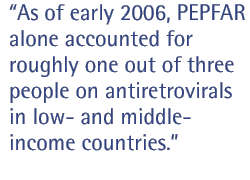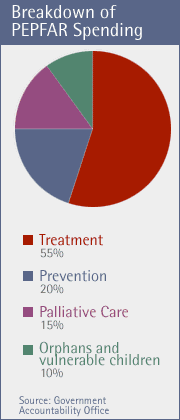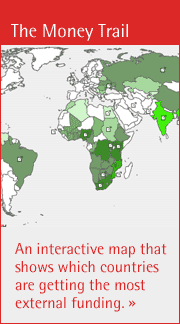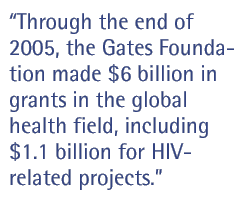Ten years ago, the world spent less than $300 million annually to combat HIV/AIDS in developing countries. In 2005, that figure reached $8.3 billion. What drove this explosion in funding, where is the money going and what are the continuing challenges? Here's a closer look.
Mike Isbell is a global health policy consultant.
In 1996, researchers uncovered the benefits of combination antiretroviral therapy and in the developed nations, at least, HIV no longer became a death sentence. At that time, the world spent less than $300 million annually on HIV-related activities of any kind in developing countries. With such meager financial resources, access to the most basic services was virtually non-existent 10 years ago in the least developed countries, where the epidemic was having its greatest impact.

But in the last decade, a sea change has occurred in the global AIDS response, prompted in part by growing media attention to the epidemic's startling impact in southern Africa, where as many as one in three adults are infected. In June 2001, global leaders meeting at the U.N. General Assembly's first-ever special session on HIV/AIDS committed to mobilize between $7 billion and $10 billion annually by 2005. Although the global community has a long history of falling short of financial commitments for international health and development initiatives, donors in this case made good on their pledge: According to UNAIDS, the world in 2005 devoted $8.3 billion toward the global AIDS response.
The explosion in funding was driven by the desire to deliver antiretroviral therapy and propelled by activist pressure and dramatic price declines in recent years. In 2003, WHO and UNAIDS launched The 3 by 5 Initiative, which established a goal of 3 million people on antiretrovirals by the end of 2005. Although the 3 by 5 Initiative fell well short of its target, with an estimated 1.3 million people on antiretrovirals by December 2005, it galvanized unprecedented global action and commitment on AIDS and definitively demonstrated the feasibility of delivering complex therapy in resource-limited settings. During the 3 by 5 Initiative, the number of people on antiretrovirals increased three-fold, including a doubling in 2005 alone. In sub-Saharan Africa, the most heavily affected region, the number of people on HIV treatment increased eight-fold in 2004 and 2005. As a result, an estimated 250,000 to 350,000 deaths worldwide were averted in 2005.
However, the increased momentum of the global AIDS response has met significant obstacles that have impeded the ability to translate financial resources into scaled-up programs on the ground. Because of limited human capacity and poorly developed infrastructure, many countries have experienced difficulty in absorbing substantial new funds. Especially in the most heavily affected countries, the multiplicity of donors has occasionally resulted in waste, duplication and poor strategic focus; in addition, multiple donor-reporting systems often increase the burden on already overstretched governments. And there have been complaints that countries have focused on broad-based prevention programs at the expense of specific at-risk populations, including sex workers, injection drug users, and men who have sex with men.
Here is a closer look at the leading international donors for HIV programs, as well as the remaining challenges regarding the financing and implementation of much-needed HIV initiatives.
U.S. Government (PEPFAR)
Even before the recent surge in financing for HIV programs, the U.S. government was the world's leading provider of bilateral HIV assistance. In the mid-1990s, the U.S. accounted for 40 percent to 50 percent of all financing for HIV programs in developing countries. In the latter years of the Clinton administration, there was a modest increase in U.S. aid for HIV after several years of stable funding.

By far, the most significant increase in U.S. financial support for HIV programs occurred in 2003, when President George W. Bush pledged to undertake a five-year, $15 billion global initiative, which included roughly $10 billion in new funding.
The program -- known as the President's Emergency Plan for AIDS Relief, or PEPFAR -- aims to:
- Provide antiretrovirals to 2 million people by 2008
- Prevent 7 million new infections
- Provide care and support to 10 million HIV-infected individuals and AIDS orphans
PEPFAR provides intensive support in 15 focus countries, mostly in Africa -- Botswana, Côte d'Ivoire, Ethiopia, Guyana, Haiti, Kenya, Mozambique, Namibia, Nigeria, Rwanda, South Africa, Tanzania, Uganda, Vietnam and Zambia -- but also provides lower-level assistance in numerous other countries. The funds support country-managed programs in each of the focus countries, with grants to major U.S.-based academic centers, non-governmental organizations, and faith-based organizations that work in partnership with national authorities.
PEPFAR's launch was especially significant because it catalyzed greater international support for treatment scale-up. In early 2006, PEPFAR was providing antiretrovirals to 471,000 people, including 401,000 in the 15 focus countries. As of early 2006, PEPFAR alone accounted for roughly one out of three people on antiretrovirals in low- and middle-income countries.
PEPFAR also supports various HIV prevention programs, including a $500 million initiative for prevention of mother-to-child transmission. Its authorizing legislation designates 20 percent of funding for prevention, although the balance between prevention and treatment differs among the 15 focus countries, depending on the nature and stage of the national epidemic.
In its first two years of operation, PEPFAR supported:
- Voluntary counseling and testing to 9.4 million people in the 15 focus countries
- Prevention services (including abstinence promotion and condom distribution) to 42 million people
- The delivery of drugs and services to prevent mother-to-child transmission to 3.1 million pregnant women
Rules governing how PEPFAR funds can be used for HIV prevention have been the source of substantial international controversy and criticism. In 2005, the Brazilian government declined to accept $40 million in U.S. HIV assistance because of requirements in American law that U.S. grant recipients formally condemn prostitution. In addition, U.S. government funds may not lawfully be used for needle-exchange programs for injecting drug users.
But the most controversy has surrounded the requirement that 33 percent of PEPFAR prevention money be spent on abstinence-only programs. Because services including HIV testing and prevention of mother-to-child transmission are included in PEPFAR's prevention portfolio, the practical effect of PEPFAR's legislative mandate is that abstinence programs consume roughly two out of three PEPFAR dollars for the prevention of sexual transmission. In 2006, the U.S. General Accounting Office, an independent agency that audits U.S. government programs, reported that legislative earmarks for abstinence programming were impeding the ability of PEPFAR country teams to devise prevention programs that meet national needs.
Global Fund to Fight AIDS, Tuberculosis and Malaria
The greatest institutional legacy of the global AIDS response is likely to be the Global Fund, which has rapidly developed into a major funder of HIV-related and other health projects in developing countries. The fund was created in late 2001; as of May 2006, it had received pledges of $8.9 billion, and as of March 31, 2006, it had approved $5.2 billion for more than 350 grants in 131 countries, with 57 percent of funding supporting HIV programs. Countries in Africa account for 55 percent of approved funding.

The Global Fund's board, which represents both donor and affected countries, makes the final decisions on who gets funding. Five funding rounds had occurred as of early 2006, and a sixth round of proposals are due on Aug 3, 2006. With the aim of promoting broad engagement in national health planning and the implementation of evidence-based programs, the Global Fund requires that countries develop grant proposals through Country Coordinating Mechanisms (CCMs). The CCMs include representation from both public and private sectors; analyses of national CCMs indicate that most include the participation of civil society, although experts say improvement is needed to enhance the CCM's diversity and representation in some countries.
Using available epidemiologic data and other information on national needs, CCMs develop funding proposals which are then assessed by a panel of technical experts. Based on projections of available funding, the board uses the technical review panel's recommendations to approve grants at specified funding levels. The Global Fund makes firm funding commitments for two years for all approved grants, with the expectation that most grants will extend over five years. Full funding is not provided at the outset but rather periodically in response to the grant's performance against criteria developed in cooperation with the fund's Secretariat. Funding flows to a Global Fund-approved Principal Recipient in each country, which is responsible for local implementation of the grant, including the monitoring of subcontractors.
As of December 2005, the Global Fund was supporting programs delivering antiretrovirals to 384,000 people -- 89 percent of whom live in Africa. It is projected that financing approved in the first five rounds will eventually:
- Provide antiretroviral treatment to more than 1.8 million people
- Reach 62 million people with HIV testing and counseling services
- Provide health care, education, and community-based support to more than 1 million children orphaned by AIDS
The Global Fund works with PEPFAR at the country level to coordinate programming and minimize overlap. In 2005-06, the Global Fund and UNAIDS established a joint problem-solving mechanism to rapidly identify and address implementation bottlenecks stemming from the limited absorptive capacity of many recipient countries, including human resource gaps, poorly developed systems for procurement and supply management, and weak mechanisms for monitoring and evaluation. The fund projects it will require $3 billion in new donations in 2006 to approve grants in the sixth round and to continue funding for initiatives approved in the first five rounds.
World Bank
Prior to the creation of the Global Fund, the World Bank was the largest multilateral funder of HIV programs, and it remains a major source of HIV financing for developing countries. Cumulative financial commitments for HIV assistance by the bank approach $3 billion.
Until recently, the bank's HIV assistance focused primarily on HIV prevention and on reinforcing health systems in resource-limited countries, but in 2004, the bank also began prioritizing HIV treatment projects in partnership with UNICEF, the Global Fund, and the Clinton Foundation. In 2004, the bank launched the Treatment Acceleration Project, a $60 million initiative to expedite treatment scale-up, including special technical assistance to countries to identify and address implementation bottlenecks. Historically, roughly half of bank financing for HIV programs has been allocated to non-governmental or other private sector groups. The World Bank and the Global Fund have been working together to enhance cooperation, reduce duplication and overlap among funded initiatives, and harmonize reporting requirements.
The bank seeks to align its HIV assistance within the broader context of country-determined national development priorities, as articulated in Poverty Reduction Strategy Papers. The bank provides countries with technical support in the development of funding proposals and in implementation of approved projects. While the bank principally operates as a lender rather than grantmaker, concessional provisions in its HIV assistance effectively mean that HIV assistance to least-developed countries function as grants.
Bill & Melinda Gates Foundation
Since its creation in 2000, the Bill & Melinda Gates Foundation has rapidly come to occupy a unique niche in the global AIDS response. With an endowment of roughly $27 billion, the Gates Foundation is the largest philanthropic organization in the United States and global health is one of its core priorities. Through the end of 2005, the Gates Foundation made $6 billion in grants in the global health field, including $1.1 billion for HIV-related projects.

A key Gates Foundation initiative is accelerated research and development on new technologies to prevent HIV infection. Through 2005, the foundation made $124 million in grants to support research on microbicides, including financing for large-scale human efficacy trials for two separate microbicide candidates. The Gates Foundation is also financing large-scale efficacy trials on a wide range of other new methods to prevent sexual HIV transmission, including adult male circumcision; female diaphragms, which may help prevent women's acquisition of HIV by preventing viral exposure of the cervix; prophylactic suppression of herpes simplex virus type 2, which significantly increases the risk of HIV transmission; and prophylactic administration of the antiretroviral drug tenofovir. Sponsors of foundation-supported trials, which actually undertake and oversee work in the field, include leading academic medical centers and large non-governmental organizations.
The Gates Foundation also plays a leading role in financing research and development on a preventive HIV/AIDS vaccine. The foundation has made grants totaling $126 million to the International AIDS Vaccine Initiative, a public-private partnership that uses the best available science to develop candidate vaccines. The foundation also catalyzed creation of the Global HIV Vaccine Enterprise, an alliance of independent entities dedicated to worldwide cooperation in answering key scientific questions that presently impede the design and development of optimally effective vaccines. HIV vaccine developments efforts could also benefit from several grants awarded through the Grand Challenges Initiative, a $450-million, foundation-financed program to accelerate research on the most important scientific questions pertaining to global health.
While prevention research is a core foundation priority, the Gates Foundation also supports visionary country-level efforts to bring HIV prevention and treatment to scale. In Botswana, the foundation has partnered with the national government and the pharmaceutical giant Merck & Co. Inc. in the first effort by any country in sub-Saharan Africa to provide universal access to HIV prevention and treatment. Avahan, the foundation's $200-million India AIDS Initiative, works in the six highest-prevalence states in India to expand access to comprehensive prevention services, with particular concentration on HIV prevention for most at-risk populations, such as sex workers, injection drug users, men who have sex with men, and truck drivers and other mobile workers.
Future Challenges
Although the world's mobilization of financial resources for HIV is unprecedented in the history of global health, current resource levels are inadequate to support the kind of response required to reverse the global AIDS epidemic. In 2006:
- Antiretrovirals reach only about 20 percent of those who need them
- Fewer than one in five individuals at high risk of HIV have access to evidence-based HIV prevention services
- Care and support services are available to fewer than 10 percent of families with children who have been orphaned or made vulnerable by AIDS
To implement a comprehensive response capable of reversing the epidemic, UNAIDS projects that annual spending of $22.1 billion will be needed by 2008 -- nearly three times more than is currently being expended.

